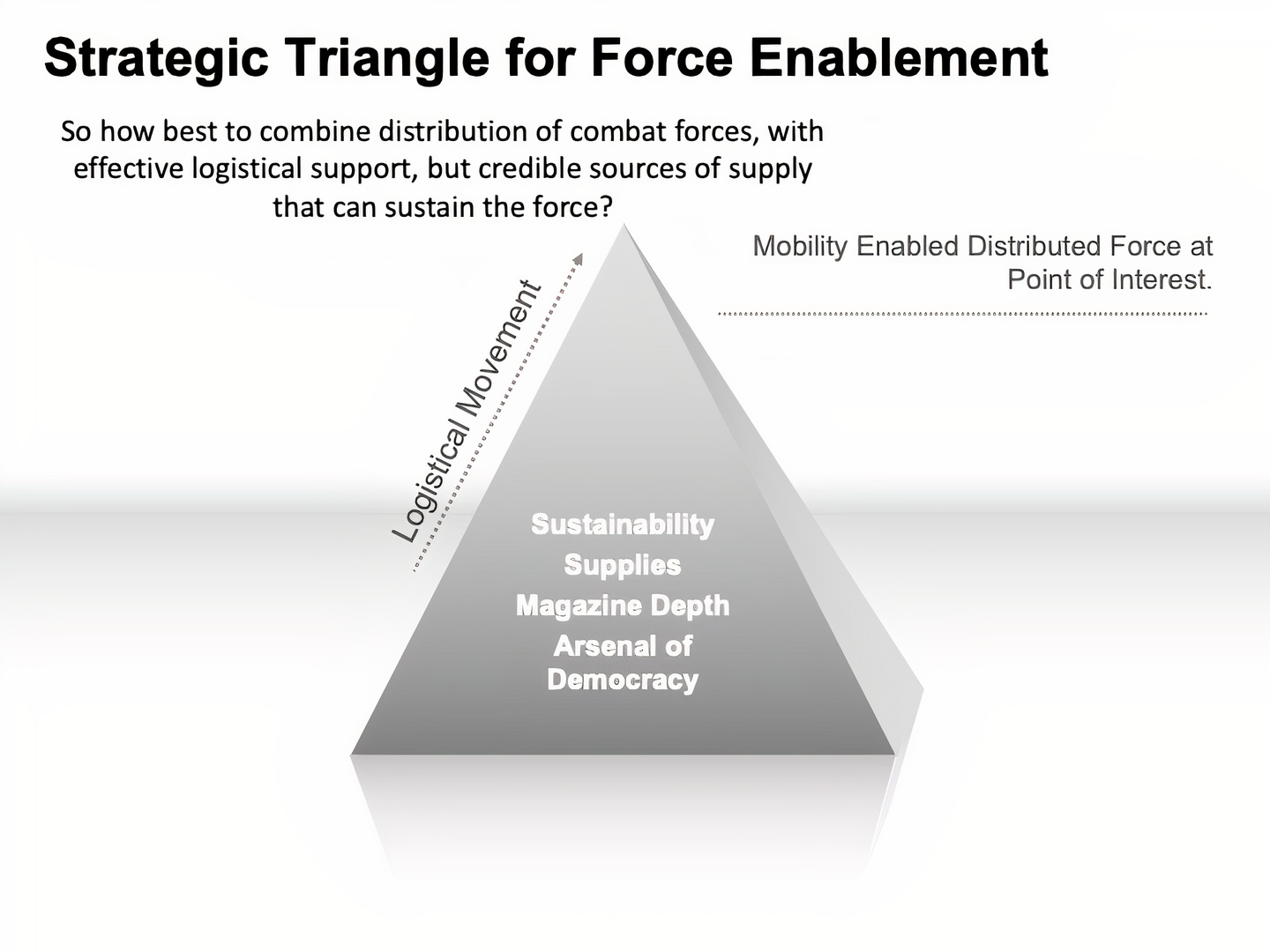By Robbin Laird
In an earlier discussion with David Beaumont, I focused on the challenge facing the ADF of managing what I called the strategic triangle for force enablement.
That triangle is conceptualized in the featured graphic for this article. At the core of the triangle is the challenge of sustainability, the provision of supplies, magazine depth and what can produced by the allied arsenal of democracy.
At the 28 March 2023 Williams Foundation Seminar, Dr. Dupont looked at the sustainability challenge as understood in terms of the capabilities of the defence industrial base. He provided an assessment of the significant limitations facing the Western industrial base to support sustainable defense forces which could endure through a significant period of conflict.
As Dupont characterized the very significant challenge facing the liberal democracies: “The country or alliance that can deliver the biggest punch and outlast adversaries will win. Right now, that is not us. The arsenal of democracy has been replaced by the arsenal of autocracy. The Ukraine conflict has exposed Australia’s and the West’s thin, under-resourced defence industrial base. If we don’t fix the problem – and quickly – we won’t prevail in a conflict with a better equipped adversary.”
This is a key challenge as the West simply has hollowed out basic consumable production for just-in time wars supported by just-in time supply chains.
But neither the industrial base nor the supply chains are up to prolonged conflict of any sort. If Australia and the West want to deter the post-Cold war legacy approach to defense industry and supply chains will simply not be adequate. A major re-think and re-structuring is in order.
I had a chance after the seminar to discuss with him on 3 April 2023 on how to do so. One could consider this a discussion of the defense industrial base, but we both think this is too limiting as it really is about shaping the entire eco-system for sustainable defense forces, which includes specific defense companies, new acquisition approaches, companies that support the core capabilities which defense taps into but are not specifically defense companies per se, and tapping into new logistical and support approaches to support distributed force.
As Dupont concluded our conversation:
“I think we should move away from this defense industrial base language which can be very clunky and 20th century. People think in terms of big factories and production and development cycles of 20 years. We need a very different focus.”
Dupont started the discussion by laying out his methodology for building what he considers to be an appropriate Australian defense industrial effort. As it stands know, Australia is almost entirely dependent on overseas supplies and when Australia orders what it needs it joins the queue along with other customers, with no certainty be supplied in a timely manner. Added to this the tyranny of distance facing the transportation of military parts to Australia, and you have a perfect storm facing Australian defence in terms of conflict.
To deal with this challenge, Australia needs to enhance its sovereign defense production capabilities. But to do so, Dupont suggests the need for a realistic methodology to shape the way ahead.
What does Australia need in terms of defense capabilities over the next two decades? How much of what it needs could realistically be produced in Australia? What can it do with co-development or co-production with key allies? And what will it simply have to procure from allied countries and producers?
In those areas where it feasible to build sovereign capabilities, a new development approach is needed. Many of the dynamic new capabilities being used by defense forces come from smaller more innovative firms. Australia has such firms but there is no Australian government policy to support them or to ensure that they have the capital to grow. There is a need for an Australian industrial policy in this area.
In areas where Australia could produce for its own needs, the government should commit to a South Korean, Israeli, or Swedish path of growing for exports. He pointed out that South Korea now exports 17 billons of dollars of exports which provides a key pillar for its own defence.
In addition, to discussing his methodology for the development of Australian sovereign defense industrial capabilities, we discussed the strategic direction of defense and how best to support it. Defence forces in the Pacific for the liberal democracies are focusing on force distribution for survivability.
There are new technologies to support force distribution such as synthetic fuel production and 3D printing in the field. New approaches to sustaining distributed forces through a relevant development and production support are crucial to provide enhanced capabilities for distributed forces.
New platform/payload combinations are being introduced through such sectors as aerial and maritime autonomous systems. How will Australia support this effort? How will it do so in a way that allows for exportability? How will it work with core allies to enhance the rapidity of change in this area?
Cost effective and expendable platforms carrying a variety of payloads are a key element of the new defense equipment ecosystem. How will this ecosystem be supported and thrive? Most likely not with old acquisition approaches and older concepts of a “defense industrial base.”
In short, a reworking of the Australian approach to supplying its forces is required. But it should be done a realistic manner but with a focus on the force structure changes taking place and the need to help sustain a distributed defense force both now and in the future.


